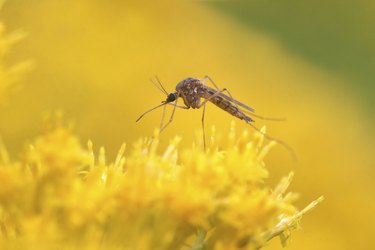Things You'll Need
10.31-percent Bacillus thuringiensis tablets
Pesticide spray containing 0.72 percent imidacloprid and 0.36 percent beta-cyfluthrin
Garden hose
Protective gloves
Twine or stakes
Safety goggles
Respirator

Itching -- the first word associated with mosquitoes -- is well deserved. Mosquitoes feed on your blood, which prompts the release of histamine from your immune system, inhibiting the introduction of infection at the cost of itching and swelling. If you have a mosquito infestation around your home, eliminate the insects at their source without relying on the old-school method of kerosene annihilation, which carries fire, environmental and health risks. If you remove mosquitoes' breeding grounds and kill them softly when you find them en masse, you'll disregard kerosene as a viable alternative.
Environmental Controls
Step 1
Remove any items or debris that could hold standing water from the problem area or invert them. Containers, pet bowls and buckets, to name a few common items, double as mosquito oases when filled.
Video of the Day
Step 2
Change out the standing water from birdbaths and children's pools and keep the water in backyard pools clean. If your pool is covered, use a squeegee to remove any standing water from the cover.
Step 3
Remove litter and lawn debris from gutters and catch basins. If your lawn has holes from uprooted trees, backfill them with sand.
Organic Controls
Step 1
Put on protective gloves. Lay one 10.31-percent Bacillus thuringiensis tablet on any permanent standing water or standing water you can't eliminate. Use one tablet in every 100-square-foot area of water.
Step 2
Tie the tablets to a fixed point using twine. You can also insert a stake through the tablets' center holes and into the ground at the bottom of the standing water to keep them in position.
Step 3
Lay one tablet per 100 square feet of dry surface that floods. Abandoned pools and bases of runoffs are a couple of examples that benefit from dry placement of mosquito tablets.
Chemical Controls
Step 1
Put on protective gear, including protective goggles and a respirator. Attach the ready-to-use pesticide-spray reservoir containing 0.72 percent imidacloprid and 0.36 percent beta-cyfluthrin to your home garden hose. Open the water flow to the hose.
Step 2
Direct the nozzle toward the areas where the target mosquitoes gather and squeeze the palm trigger. Expend enough pesticide to coat, not saturate; super-saturation is extraneous. If your target is a still body of water, aim over the water but not into it.
Step 3
Allow the mosquitoes to fall, and then skim them from the water, ground or surface where they expired. Sprays eliminate mosquitoes on contact; one comprehensive spray suffices in a suburban setting.
Warning
Wear protective coverings when you handle and apply pesticides. Gloves and goggles are necessary; if you have an aversion to chemicals, long sleeves and pants are in order. Wash your hands after using. Keep children and pets out of any areas where pesticides have been sprayed. Always spray in a straight line to your target.
Video of the Day